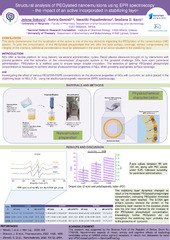| dc.description.abstract | INTRODUCTION
Nanoemulsions (NEs) offer a flexible platform for drug delivery via several administration routes. Rapid plasma clearance brought on by interactions with plasma proteins and the activation of the mononuclear phagocytic system is the greatest challenge NEs face after parenteral administration. PEGylation, or adding PEGylated phospholipids to the stabilizing layer of the NEs, is one method for ensuring that droplets circulate for a longer period of time. It is crucial to select the optimum concentration of the PEGylated in order to maintain the necessary physicochemical properties of NEs while providing appropriate surface coverage with the PEG chains. Curcumin is a model active that has been found to be localized in the stabilizing layer of NEs (1-3) and offers a wide range of potential health benefits, but due to its short plasma half-life, new strategies for enhancing bioavailability are required. The purpose of this study is to investigate the effects of various PEGylated phospholipid (PEG2000-DSPE) concentrations on the structural properties of NEs with an active placed in the stabilizing layer.
PREPARATION OF NANOEMULSIONS
All the NEs were prepared using the high pressure homogenization technique. The aqueous phase (glycerol, polysorbate 80, sodium oleate and highly purified water) was added to the oil phase (soybean oil, medium chain triglycerides, soybean lecithin, buthylhydroxytoluene, curcumin and 0.1%/0.3%/0.6% PEG2000-DSPE) and mixed at 11000rpm for 1 min on rotor stator homogenizer (IKA Ultra-Turrax T25 digital, IKA-Werke GmbH & Co. KG, Staufen, Germany), and then further processed at 800 bar for 10 discontinued cycles (EmulsiFlex-C3, Avestin Inc., Ottawa,ON, Canada) to obtain CS21, CS23 and CS26 formulations.
NANOEMULSION DROPLET SIZE
The droplet size was assessed through the dynamic light scattering method and presented as mean droplet size (Z-ave) and polydispersity index (PDI), after diluting the NEs 1:500 (v/v) in highly purified water.
ELECTRON PARAMAGNETIC RESONANCE (EPR) SPECTROSCOPY
For this study three amphiphilic fatty acid derivatives labeled at different positions of the aliphatic chain (5-DSA, 12-DSA and 16-DSA) were used to probe the dynamics of the membrane at different depths. Stock solutions of the spin probes were prepared in absolute ethanol at 1mM concentration. Subsequently, 15 µl of the stock solutions were evaporated and then incubated with 1 ml of the NE sample in final concentration of 0.015 mM. The resulting spectra was analyzed in terms of rotational correlation time (τR), order parameter (S) and isotropic hyperfine constant (αN).
RESULTS AND DISCUSION
All of the formulations had average droplet sizes between 95 and 103 nm and PDI values under 0.25, which indicated that they were suitable for parenteral administration.
The results of the EPR investigation showed that the stabilizing layer changed as the amount of PEGylated phospholipids increased, indicating that the PEGylation threshold has not yet been reached in the stabilizing layer.
The EPR research also showed that the 5-DSA spin probe's spectra were significantly affected by the addition of various PEGylated phospholipid concentrations (Figure 1). This indicates that the portion of the stabilizing layer nearest to the aqueous phase was the one most affected by the increase in the PEGylated phospholipid concentration. Table 1 provides the calculated values for the spectrum parameters. The mobility of the spin-probe and the time it takes for the spin-probe to make a full rotation is reflected in the τR parameter, which was changed the most, compared to the other parameters, by the variations in the PEGylated phospholipid content. A formulation with the most rigid stabilizing layer had the largest τR values, which, in this instance, was the formulation with 0.1% PEG2000-DSPE. It's interesting to note that the addition of PEGylated phospholipid had the opposite effect of strengthening the stabilizing layer. Further PEG2000-DSPE addition appeared to result in nanoemulsions with a less rigid stabilizing layer, possibly indicating that larger concentrations of the PEGylating agent lead to interface destabilization. The interactions between the curcumin, a symmetrical molecule with two aromatic ring systems and a bent conformation located in the stabilizing layer and the extra stabilizer are likely responsible for this.
The other two spin probes (12-DSA and 16-DSA) provide information about the stabilizing layer located closer to the oil core. Based on the data provided in Table 1 it can be inferred that the PEGylation mostly affects the stabilizing layer's areas closest to the aqueous interface, leaving the parts closer to the oil core largely not impacted.
CONCLUSION
This study demonstrates that one of the key elements in assessing how PEGylation affects the NE system is the active's localization. To pick the concentration of the PEGylated phospholipid that will offer the best surface coverage without compromising the integrity of the interface, additional considerations must be addressed in the event of an active situated in the stabilizing layer. In this instance, it may be hypothesized that the lowest PEG2000-DSPE concentration of 0.1%, CS21, will produce NEs that can slow down curcumin release the most compared to the other two formulations. Additionally, given that further addition of the PEGylated phospholipid causes the formation of less rigid stabilizing layer, further inquiries should be made to see the impact of these changes on the interactions with plasma proteins and biological fate of the droplets upon administration. | sr |

